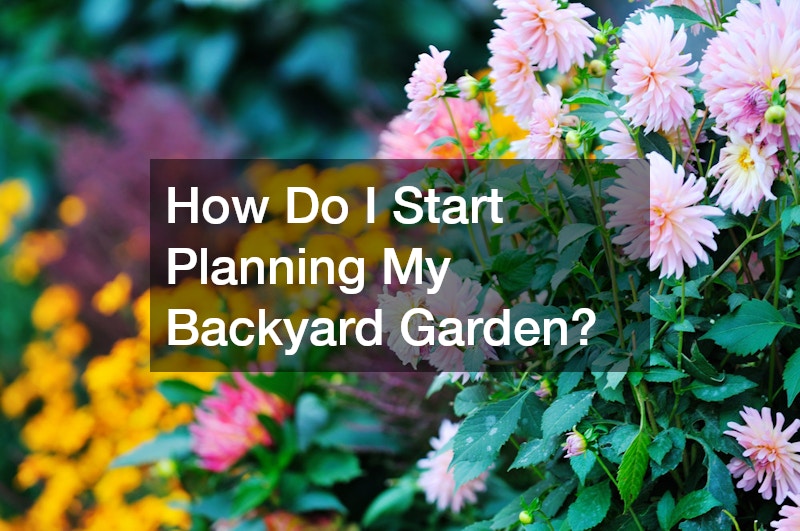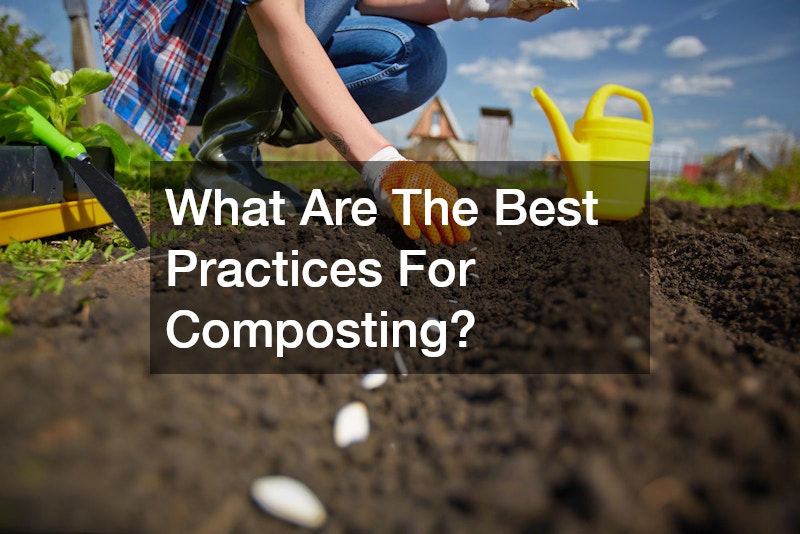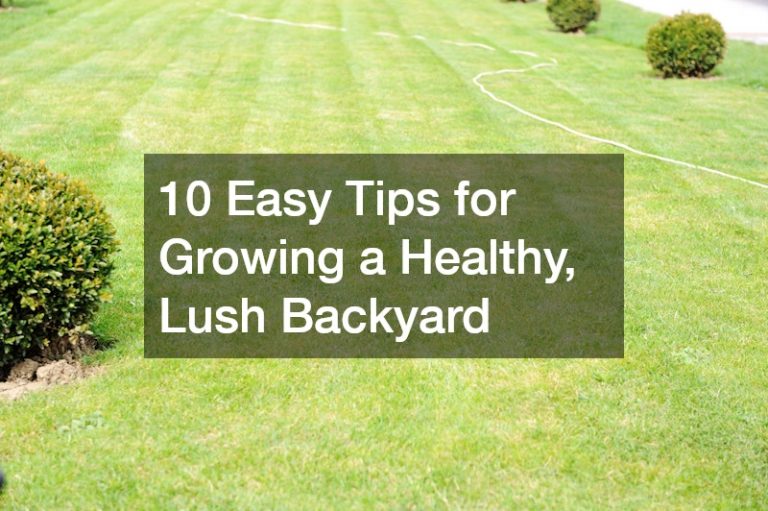A lush backyard is more than just an outdoor space — it’s a personal retreat, a haven for wildlife, and a source of pride. If you’ve ever dreamed of stepping outside to a vibrant, green sanctuary where every plant flourishes and every corner feels alive, you’re not alone. But achieving such beauty doesn’t happen overnight. It takes thoughtful planning, consistent care, and a little know-how.
In this comprehensive guide, we’ll share ten easy, proven tips to help you grow and maintain a healthy, lush backyard. Whether you’re a weekend warrior tackling the garden for the first time or a seasoned green thumb looking for a few fresh ideas, these insights will get you closer to your goal. Along the way, we’ll cover key practices like soil preparation, composting, pruning, and much more. We’ll also touch on how tree services, lawn fertilizing, and even local tree companies can support your efforts.
By the end of this article, you’ll feel equipped and inspired to transform your backyard into the vibrant, thriving space you’ve always wanted. Let’s dive into the steps you need to take to create your own lush backyard paradise.
1. How Do I Start Planning My Backyard Garden?

Transforming your outdoor space into a lush backyard starts with smart planning. Every successful garden begins on paper before it comes to life in soil.
1.1 Understanding Your Climate and Soil Type
Before planting anything, get familiar with your region’s climate and your backyard’s soil type. Knowing whether your area is arid, temperate, or tropical will help you choose plants that thrive in your conditions. Similarly, test your soil to understand its texture and nutrient levels. Sometimes sod can help improve bare areas quickly while you work on long-term planting solutions.
1.2 Choosing the Right Plants for Your Space
Pick plants suited to your climate, sun exposure, and available space. This minimizes maintenance and helps ensure healthy growth. If you’re working with a smaller yard, consider vertical gardening or container plants to make the most of the area. Local tree companies often have excellent advice about which trees and shrubs grow best in your area.
1.3 Designing Your Garden Layout
Design your garden with both aesthetics and function in mind. Group plants by water and sunlight needs. Add pathways, seating, and focal points like a flowering tree or water feature. Many arborists recommend incorporating trees strategically, as they provide shade and contribute to the lushness of your backyard.
2. What Types Of Soil Amendments Should I Use?
Healthy soil is the foundation of a lush backyard. The right amendments can transform poor soil into a thriving environment for plants.
2.1 Benefits Of Organic Matter
Adding organic matter such as compost, manure, or leaf mold improves soil texture, increases water retention, and boosts nutrient levels. It also encourages earthworms and beneficial microbes.
2.2 The Role Of pH Balance In Soil Health
Test your soil’s pH and adjust it if necessary. Most plants prefer slightly acidic to neutral soil. Amendments like lime or sulfur can help correct extreme pH levels and promote better nutrient absorption.
2.3 Using Fertilizers: Organic vs Synthetic
Fertilizers replenish nutrients that plants deplete over time. Lawn fertilizing is critical for grass health, and many gardeners opt for slow-release organic options. However, synthetic fertilizers can also work if used sparingly to avoid runoff and damage to delicate plants.
3. How Often Should I Water My Plants?
Consistent and proper watering is essential to maintaining a lush backyard. Too much or too little can harm plants, so it’s crucial to strike the right balance.
3.1 Understanding Plant Water Needs
Different plants have different water requirements. Pay attention to the specific needs of your lawn, flowers, shrubs, and trees. Newly laid sod needs frequent watering until it establishes, whereas mature trees may only need occasional deep soaks.
3.2 Best Watering Techniques
Water early in the morning to reduce evaporation and prevent disease. Aim for deep, infrequent watering to encourage strong root systems instead of shallow, daily sprinkles.
3.3 Efficient Irrigation Systems
Installing drip irrigation or soaker hoses can save water and deliver it directly to plant roots. For larger lawns, sprinklers with timers help ensure even, efficient coverage. Local tree contractors can also advise on irrigation options that benefit both trees and grass.
4. What Are The Best Practices For Composting?

Composting is a great way to enrich your soil and reduce household waste — a win-win for your lush backyard.
4.1 Starting A Compost Pile
You don’t need fancy equipment to start. A simple pile in a corner of your yard works just fine. Combine “greens” (like vegetable scraps) with “browns” (like dried leaves) to create balanced compost.
4.2 Maintaining The Right Compost Balance
Turn your pile regularly to aerate it and keep it from smelling. Keep it moist but not soggy, and aim for a balance of materials to speed up decomposition.
4.3 Utilizing Compost In Your Garden
Once it’s ready, spread compost around your plants, mix it into garden beds, and even use it when laying sod. Compost improves soil fertility naturally, reducing the need for chemical fertilizers.
5. How Can I Control Pests Naturally?
Pests can wreak havoc on your backyard if left unchecked. Natural control methods keep your garden healthy without harming beneficial insects.
5.1 Identifying Common Garden Pests
Learn to recognize signs of infestation from aphids, slugs, beetles, and other common pests. Some problems can also arise in trees, so hiring tree services or consulting arborists might be necessary for a severe outbreak.
5.2 Attractive Strategies For Beneficial Insects
Encourage ladybugs, spiders, and predatory wasps, which naturally keep pests in check. Planting flowers that attract these insects can help maintain balance.
5.3 Homemade Remedies For Pest Control
Simple sprays made from soap and water, neem oil, or chili can deter many pests. Avoid overusing chemicals that could damage your lush backyard ecosystem.
6. How Do I Promote Healthy Plant Growth?
Healthy plants are the hallmark of a lush backyard. A few key practices can help your garden flourish year-round.
6.1 Pruning And Deadheading Techniques
Prune shrubs and trees to remove dead branches and encourage new growth. Tree pruning also enhances air circulation and sunlight penetration. Local tree companies often provide professional pruning services, especially for large or delicate trees.
6.2 Mulching For Moisture And Nutrients
Mulch helps conserve moisture, suppress weeds, and regulate soil temperature. Spread mulch around plants but keep it away from stems to prevent rot.
6.3 Rotating Crops And Companionship Planting
Rotate annual crops to avoid depleting soil nutrients and reduce disease risks. Companion planting can also enhance growth and deter pests naturally.
7. What Are The Common Diseases To Watch For?

Even with the best care, plants can sometimes get sick. Being proactive and observant is key.
7.1 Identifying Symptoms Of Plant Diseases
Look for signs like wilting, yellowing leaves, spots, or stunted growth. Trees can also show distress, so periodic inspections by arborists are wise.
7.2 Preventative Measures Against Diseases
Good air circulation, proper watering, and clean tools help prevent disease. Regular lawn fertilizing also strengthens grass against fungal infections.
7.3 Treatments And Solutions For Affected Plants
Remove and dispose of diseased plants if necessary. Use organic or chemical treatments sparingly and follow label instructions carefully to avoid harming beneficial organisms.
8. How Can I Encourage More Biodiversity?
A truly lush backyard is full of life — not just plants, but animals and insects too. Biodiversity plays a crucial role in creating a balanced, thriving ecosystem where different species work together to maintain soil health, control pests naturally, and support plant pollination.
8.1 Planting A Variety Of Plants And Flowers
Diversity in planting attracts a wider range of beneficial wildlife. Mix perennials, annuals, shrubs, and trees to create layers of habitat. Incorporating native species is particularly effective, as these plants are adapted to local climates and provide food and shelter for regional pollinators and wildlife. Seasonal variety is also key—by choosing plants that bloom at different times, you ensure a continuous food source throughout the year.
8.2 Attracting Pollinators To Your Garden
Bees, butterflies, and birds play a critical role in pollination. Choose native flowering plants to draw them in and keep your garden blooming. Installing features like bee hotels or butterfly houses can encourage these pollinators to stay and reproduce. Water sources such as shallow dishes or birdbaths also provide essential hydration for these creatures, helping maintain a healthy population in your backyard.
8.3 Creating Habitats For Wildlife
Install birdhouses, water features, and brush piles to provide shelter for small animals. A healthy, lush backyard supports a dynamic and resilient ecosystem. Leaving patches of your yard a little wild or undisturbed creates valuable habitats for insects, amphibians, and small mammals. You can also add natural elements such as logs or stones to offer hiding spots and nesting sites, making your backyard a sanctuary for wildlife.
9. What Role Do Trees And Shrubs Play?
Trees and shrubs are essential elements of any lush backyard, offering beauty, structure, and function. They provide shade, shelter, and food sources for a variety of wildlife, contributing to biodiversity and creating a more inviting outdoor space. Trees help regulate temperature by cooling the air and reducing heat, while shrubs can act as natural barriers to block wind or noise.
9.1 Selecting The Right Trees For Your Climate
Choose trees that thrive in your region to minimize maintenance and improve survival rates. Some local tree contractors even offer planting services and warranties. When selecting species, consider factors such as growth rate, mature size, and resistance to local pests or diseases. Deciduous trees provide seasonal shade and allow winter sunlight to warm your home, while evergreens offer year-round privacy and wind protection. Consulting with arborists can help you choose species that suit your backyard’s microclimate and long-term goals.
9.2 Benefits Of Shrubs In A Garden Landscape
Shrubs provide year-round interest, privacy, and habitats for wildlife. They also help prevent erosion and fill gaps between trees and smaller plants. In addition to their ecological roles, shrubs add texture, color, and seasonal blooms that can enhance the aesthetic appeal of your backyard. Certain flowering shrubs attract pollinators, while berry-producing varieties provide food for birds and small mammals. Layering shrubs at various heights also creates natural screening and softens hardscape elements like fences or patios.
9.3 Proper Care And Maintenance For Trees
Trees need regular care to stay healthy. Tree trimming, tree removal of hazardous limbs, and stump grinding can keep your yard safe and beautiful. Hiring tree services or arborists ensures the work is done correctly and safely, just keep an eye on the stump grinding cost. Proper pruning promotes strong branch structure and reduces the risk of disease. Regular inspections can catch problems early, such as pest infestations or root damage. Seasonal maintenance like mulching and watering during dry spells further supports tree vitality, especially for younger or newly planted specimens.
10. How To Design A Low-Maintenance, Sustainable Backyard?

A lush backyard doesn’t have to consume all your time. With the right choices, you can enjoy a beautiful garden with minimal effort.
10.1 Choosing Drought-Tolerant Plants
Native and drought-tolerant plants require less water and maintenance, making them perfect for busy gardeners. They are adapted to local climate conditions and often resist pests and diseases better than non-natives. Succulents, ornamental grasses, and many flowering perennials can provide vibrant color and texture year-round without demanding excessive care. Grouping these plants according to their water needs allows for efficient irrigation, conserving resources while supporting plant health.
10.2 Implementing Sustainable Gardening Practices
Use rain barrels, compost, and organic mulch to conserve resources and build a healthier environment. Rainwater harvesting reduces dependence on municipal water and helps maintain moisture levels during dry periods. Regular composting returns nutrients to the soil and supports beneficial microbial activity, which boosts plant resilience. Organic mulches not only conserve moisture but also improve soil structure as they break down. Sustainable gardening means minimizing chemical inputs and encouraging natural cycles that keep your lush backyard thriving.
10.3 Utilizing Smart Garden Technology
Automated irrigation systems, soil sensors, and smart lighting make it easier than ever to maintain a lush backyard with less effort. Local tree companies and tree contractors often offer consultations to integrate these systems with your landscape. Soil moisture sensors can prevent overwatering by triggering irrigation only when plants need it, saving water and preventing root rot. Smart timers and app-controlled systems provide flexibility and convenience, especially for busy homeowners. Proper lighting enhances safety and extends outdoor enjoyment into the evening without excessive energy use.
Conclusion
Creating a healthy, lush backyard is a rewarding journey that pays off every time you step outside. With these ten tips — from planning and planting to maintenance and sustainability — you can cultivate an outdoor space that reflects your personality and enhances your life.
Remember, it’s not just about the plants. Trees, shrubs, and even the smallest details contribute to the overall look and health of your garden. By working with professionals like arborists, tree contractors, and local tree companies when needed, you’ll ensure your backyard stays vibrant and safe. Lawn fertilizing, tree trimming, tree pruning, and even the occasional tree removal or stump grinding are part of keeping everything in balance.
Above all, take your time and enjoy the process. A lush backyard grows more beautiful with every season, providing peace, joy, and a connection to nature. So grab your gloves, call in some help when needed, and start creating the lush backyard of your dreams today.
Happy gardening!
